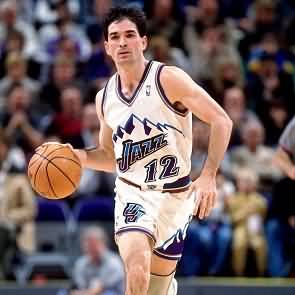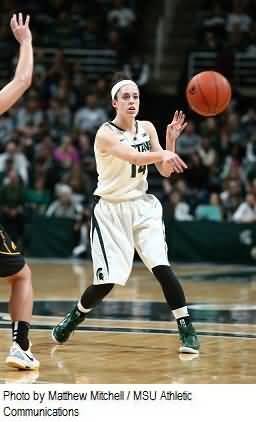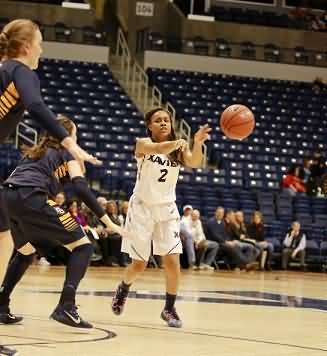Basketball Passing Fundamentals - the Art of Passing
By Dr. James Gels, From the Coach’s Clipboard Basketball Playbook"Helping coaches coach better..."
Basketball passing fundamentals are critical to good team play. "The quality of the pass leads directly to the quality of the shot." - former Princeton coach Pete Carril
Remember the line, "Where have you gone Joe DiMaggio?" For this topic, it's "Where have you gone Magic Johnson?" Magic was a great, unselfish TEAM player who may have been the greatest passer of all time (although John Stockton was pretty good too).
Television focuses on pros doing 1-on-1 moves and slam dunks. Kids see this too. Team skills and delivering the perfectly timed and accurate pass aren't as flashy. Besides, who wants to do passing drills - players find them boring.
On the other hand, excellent passing is the essence of outstanding team play, and it is fun to watch a perfectly timed and delivered pass for an easy lay-up (or dunk). Poor passing and turnovers will kill your offense. A bad pass results in a turnover, no shot taken and an opportunity to score is lost. Coaches must continue to find ways to teach players to become better passers.
Passing seems very easy when you have two players facing each other practicing chest passes or bounce passes. But put a defender on each one of them, and it becomes difficult. So, you must do passing drills with defenders involved to simulate game situations.
Also, I think passing drills that involve players passing and catching on the move are better than stationary drills, since seldom in a game do you pass to someone standing still.
Passing fundamentals
A good pass is one that is caught by a receiver who is not in "traffic", surrounded by defenders. Successful passing involves two parts, making the pass and receiving the pass. The receiver should have "soft" (relaxed) hands, catch the ball with both hands and look the ball into his/her hands. The receiver should, in most cases, be moving toward the pass - "meet the pass".Most of the time, the receiver should not be stationary. The receiver must learn to get open by making V-cuts and back-cuts, and setting screens for other teammates and then sealing the defender and "rolling" off those screens (see Cutting and Faking, Setting and Using Screens). Receivers should always know where the ball is.
When passing (and receiving), use two hands. The three basic passes are the chest pass, bounce pass and overhead pass (also later consider the behind-the-back pass and the baseball pass). The technique is the same with all three - step toward the receiver, and extend the arms toward the receiver, with palms out and thumbs down. Be accurate and deliver the pass exactly where the receiver wants it.
A big part of passing is making correct decisions with the ball. Make the simple pass, the easiest pass that will get the job done. Don't make a crazy behind the back pass just to be "flashy", when a simple chest or bounce pass will work.
Now there are times when a properly executed, behind the back pass is the correct pass to make (e.g. 2-on-1 break with the defender right in front overplaying you on the ball side). But we don't make that pass to be "flashy" - we make it because it is the easiest and the correct pass in that situation.
If a defender is in the passing lane, don't force the pass. You should not pass into the defense, or "into a crowd" where your receiver is surrounded by defenders - sounds obvious but I see it all the time. Pass away from the defense. "See the defense".
Do not pass to a receiver who is not in a good position to receive the ball. An example is passing up the floor against a press where your receiver has his/her back turned away from the hoop and there is a defender coming up on the blind side.

John Stockton
This next point is very important. A good passer knows how to open the passing lanes by making a pass-fake (see video) in one direction, and then passing the opposite direction. Legendary coach Bob Knight has said that two of the most important and under-taught fundamentals are the pass-fake and the shot-fake.
We use the phrase, "fake a pass to make a pass." Making a ball fake, head bob, pass fake, or just looking the opposite direction ("looking the defender off") will often open the desired passing lane. Do not look right at the receiver and "telegraph" the pass.
Use your peripheral vision, keep your eyes forward and know where your teammates are. Bad passes can result from dribbling with your head down, not seeing the defense, and then making a pass to a defender who slips into the passing lane.
A good passer knows how to deliver the ball with "touch" - that is, with just the right velocity and angle to make it an easy catch for the receiver. A pass can be in the perfect location, but if it is too hard, it is uncatchable. If your pass is too soft, the defense can intercept it.
You must learn to "anticipate" - that is, pass the ball to where your teammate will be, not where he/she is right now. Lead the receiver; don't pass behind him/her. Good passing involves timing and communication between the passer and receiver. That's why it is not an easy skill to master as it involves two players working together.
Both the passer and the receiver must read the defense.
Learn to "drive and dish" by making a penetrating dribble move, drawing the defense, and then making a bounce pass to a post player under the hoop, or a kick-out pass to the wing or corner for a 3-pointer.
Just like shooting, you must be under control when you pass. You should be balanced with both feet on the floor. When speed-dribbling up the floor on a fast-break, keep your eyes forward and stay under control so you can deliver the pass to the open teammate at the precise, correct moment.
I see the following subtle passing error made occasionally on the fast break. The player speed-dribbling the ball up the floor, when making the final pass on the break, will sometimes at the end of the dribble bring the ball back on the hip to get more velocity on the pass. A hustling defender comes up from behind and pokes the ball loose. It usually goes out-of-bounds, but you have lost a chance to score a lay-up. When making this pass, keep the ball in front of you.
Unless you are a very skilled player, don't get into the habit of jumping when you pass. If you jump when you pass, and the defense closes the passing lane while you are airborne, you're in trouble.
See these Tips for Better Passing that will help you become a good passer and help you avoid passing turnovers.

Let's take a few specific instances:
Point Guard to Wing pass
The wing player should make a V-cut and the passer should time the pass for when the receiver breaks back out of the V-cut. If the defender is back off the wing player, pass the ball right into the "shooting pocket", on your teammate's side facing the hoop, so that he/she is immediately is position to release the shot. If the pass is made to the outside, the receiver must first pivot and square up before he/she can shoot.Now, if the defender is up closer, make the pass to the outside of your teammate. If the defender is in the passing lane, your teammate should make a back-cut to get open. If not, it's a difficult pass and he/she will not be open for a shot, so you should look to pass elsewhere, or make a move yourself. Another point - the pass to the back-cutter is often a nice bounce pass leading the receiver.
Perimeter Passing
Contrary to what is often taught, the chest pass is not real good here. To make a chest pass, you must have a clear passing lane directly in front of you. If the defender is in front of you, a pass that comes from your chest area is easily deflected. Use either the lateral pass or the two-handed overhead pass.In making the lateral pass, you fake opposite and then cross your opposite foot (the foot which is away from the direction of the pass) in front of you and step in the direction of the pass. You deliver the pass with some "zip" on it so it cannot be intercepted.
For example, if you want to pass to the right, you make a fake to the left and then cross your left foot over in front of you while pivoting on your right foot and make the pass to the right. This is almost like a chest pass except the pass is not released from the center chest area, but more from your side.

The two-handed overhead pass
This pass is often used as an outlet pass after a rebound, or for a "skip" pass (a cross-court pass over a zone defense). It can also be used to quickly move the ball around the perimeter. Your target is your teammate's head - a little higher than the chest. In making this pass, do not bring the ball back behind your head… keep it straight up (or slightly in front) and over your head.Passing into the Post
Timing is important. The pass should be made as the post player is cutting into his/her post position. A bounce pass is easiest to catch, but sometimes an "air pass" (no bounce) is needed especially when passing from the top.When the ball is on the wing, the pass to the low post should be made quickly before the defense is set. The passer should clear the passing lane by making a good fake. Learn how to make the "step-around" bounce-pass (fake an overhead pass, and with the non-pivot foot make a long stride around the defender to improve the passing angle. Pass to the side away from the post defender.
If the post defender is half-fronting on the baseline side, make the pass from the high side, and perhaps even take one quick dribble up for a better passing angle from the high side. If the post defender is half-fronting from the lane side, make the pass from the baseline side.
When the low post is fronted, a lob pass over the top can be attempted, but only if your post player has a clear advantage as this pass is often unsuccessful.
Passing Drills
See the standard passing drills on this website. In addition, use drills where defense is played against the pass. Passing is easy and not game-like without defenders. It becomes a very difficult skill once defenders are in place.Drills that involve players passing and catching on the move are better than stationary drills, since seldom in a game do you pass to someone standing still.
You can design your own simple drills. One would be to practice the pass from point to wing and back, using one or two defenders. Teach the V-cut and back-cut. Teach the point guard how to make a nice leading bounce pass to the back-cutter.
Another drill practices the wing to low post pass using two defenders. Teach the passer how to fake and open the passing lane and how to make the "step-around" bounce pass (see above). He/she must also recognize the correct target. If the post defender is playing on the baseline side, from the high side of your defender, pass to your teammate's hip on the lane side. If the post defender is playing on the lane side, pass to your teammate's baseline hip.
5-on-5 drill. Put your offense in a half-court set against man-to-man defense. Have them pass against this defense with no dribbling allowed, except for a one or two bounce dribble to attack the hoop, or a drive and dish. After five possessions, switch offense and defense. Make sure your receivers are making good V-cuts or back-cuts and moving toward the ball when receiving. Here also is an opportunity to stress the importance of setting good screens. Most passes are caught with two hands with the receiver in triple threat position.
Also practice 5-on-5 passing against various zones, again with no dribbling. Move the ball quickly to over-shift the zone. Use the two-handed overhead pass and skip passes. Read the gaps in the zone. Not only do these drills help your passing, but also help your team to learn how to break zone defenses down - and it's a lot more fun than just doing simple partner passing drills.
Related pages:
- Tips for Better Passing
- Full-Court 2-Line Passing Drills
- Full-Court Weave Passing Drills
- Full-Court Passing Drills
- Half-Court Passing Drills
- Press Break Passing Drill